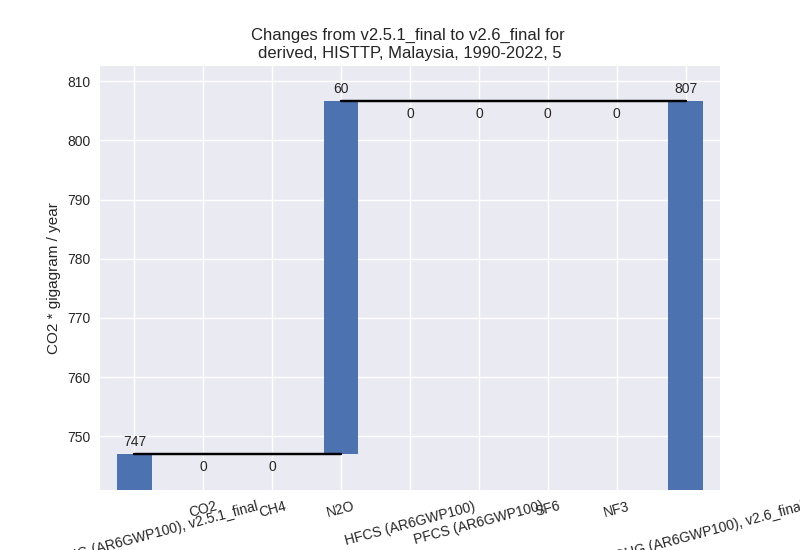Changes in PRIMAP-hist v2.6_final compared to v2.5.1_final for Malaysia
2024-09-24
Johannes Gütschow
Change analysis for Malaysia for PRIMAP-hist v2.6_final compared to v2.5.1_final
Overview over emissions by sector and gas
The following figures show the aggregate national total emissions excluding LULUCF AR6GWP100 for the country reported priority scenario. The dotted linesshow the v2.5.1_final data.
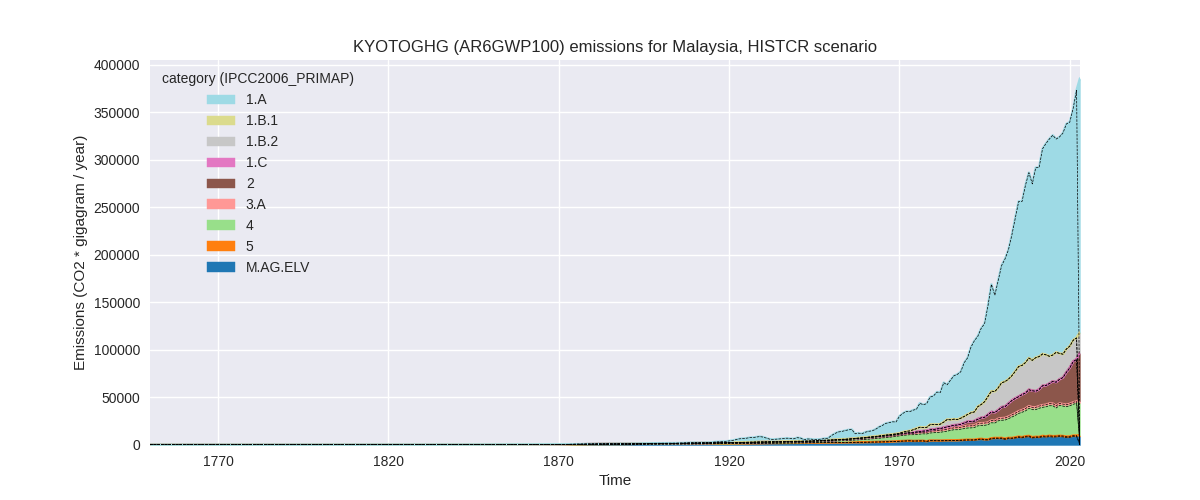
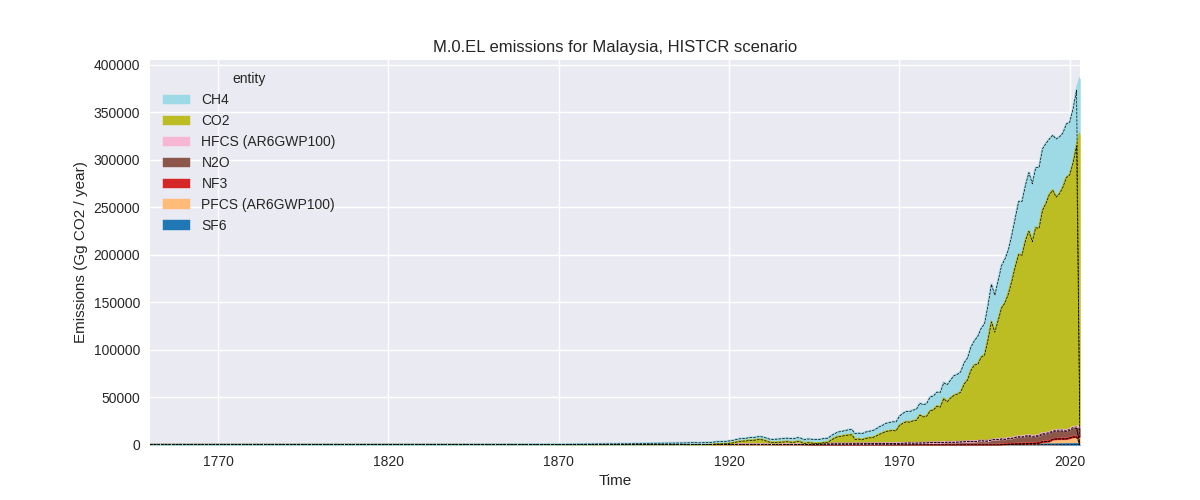
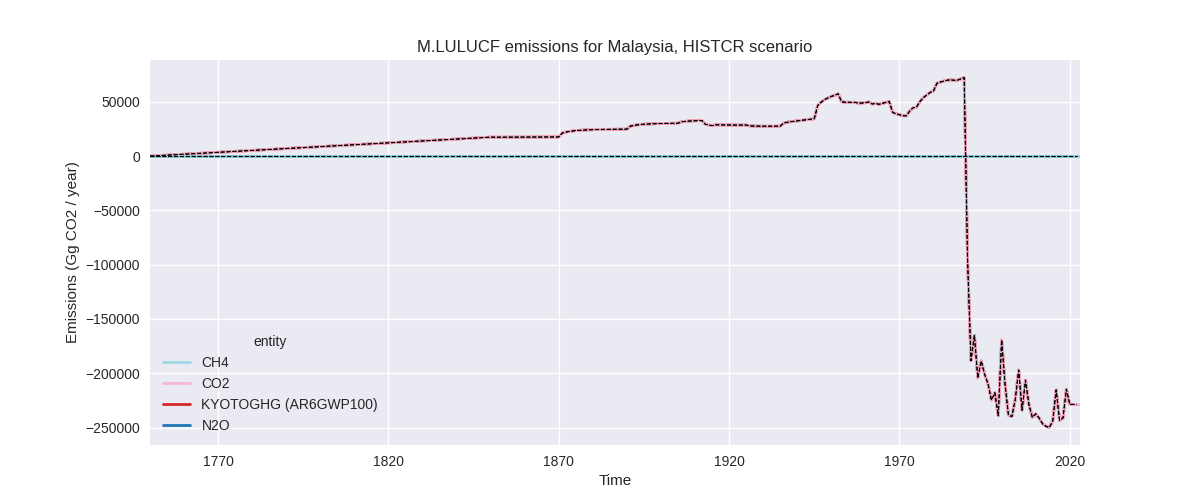
The following figures show the aggregate national total emissions excluding LULUCF AR6GWP100 for the third party priority scenario. The dotted linesshow the v2.5.1_final data.
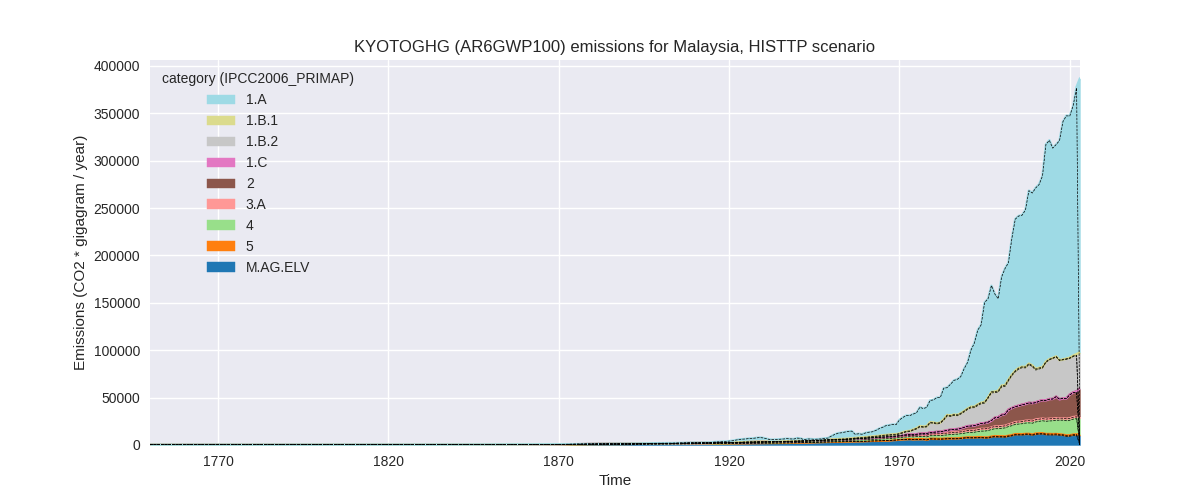

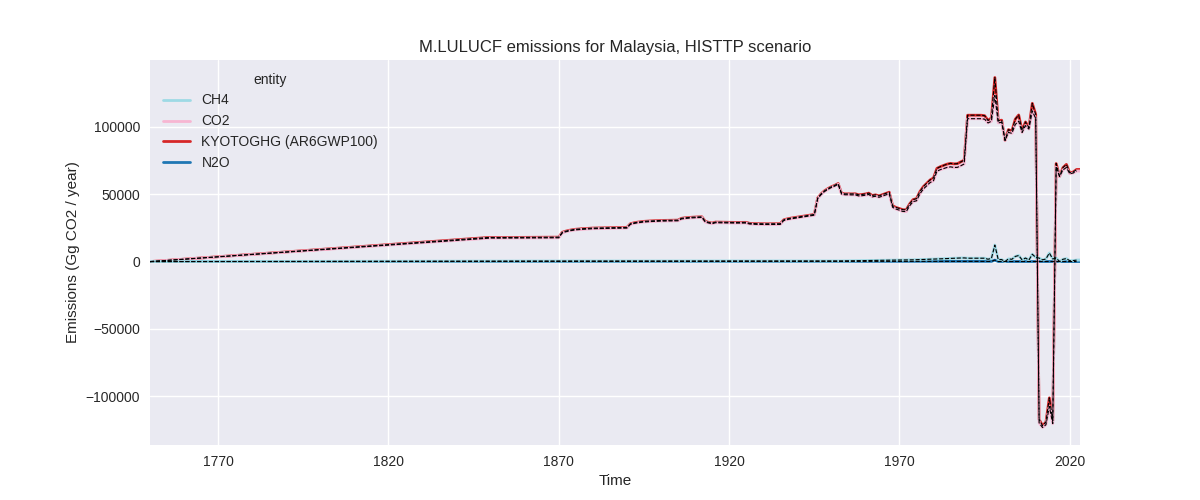
Overview over changes
In the country reported priority scenario we have the following changes for aggregate Kyoto GHG and national total emissions excluding LULUCF (M.0.EL):
- Emissions in 2022 have changed by 0.0%% (89.93 Gg CO2 / year)
- Emissions in 1990-2022 have changed by 0.0%% (35.83 Gg CO2 / year)
In the third party priority scenario we have the following changes for aggregate Kyoto GHG and national total emissions excluding LULUCF (M.0.EL):
- Emissions in 2022 have changed by 0.3%% (1063.25 Gg CO2 / year)
- Emissions in 1990-2022 have changed by 0.0%% (41.95 Gg CO2 / year)
Most important changes per scenario and time frame
In the country reported priority scenario the following sector-gas combinations have the highest absolute impact on national total KyotoGHG (AR6GWP100) emissions in 2022 (top 5):
- 1: 2, SF6 with 91.99 Gg CO2 / year (14.6%)
- 2: 1.A, CO2 with -77.98 Gg CO2 / year (-0.0%)
- 3: 1.B.2, CO2 with 22.34 Gg CO2 / year (0.8%)
- 4: 5, N2O with 20.57 Gg CO2 / year (2.0%)
- 5: 2, PFCS (AR6GWP100) with 17.13 Gg CO2 / year (0.2%)
In the country reported priority scenario the following sector-gas combinations have the highest absolute impact on national total KyotoGHG (AR6GWP100) emissions in 1990-2022 (top 5):
- 1: 5, N2O with 59.68 Gg CO2 / year (8.0%)
- 2: 1.A, CO2 with -43.52 Gg CO2 / year (-0.0%)
- 3: 2, SF6 with 6.56 Gg CO2 / year (2.3%)
- 4: 4, CH4 with 1.54 Gg CO2 / year (0.0%)
- 5: 1.B.2, CO2 with 1.51 Gg CO2 / year (0.0%)
In the third party priority scenario the following sector-gas combinations have the highest absolute impact on national total KyotoGHG (AR6GWP100) emissions in 2022 (top 5):
- 1: 2, PFCS (AR6GWP100) with 847.63 Gg CO2 / year (50.9%)
- 2: 4, CH4 with 135.64 Gg CO2 / year (0.8%)
- 3: 1.A, CO2 with -84.56 Gg CO2 / year (-0.0%)
- 4: 2, SF6 with 72.04 Gg CO2 / year (11.4%)
- 5: 2, HFCS (AR6GWP100) with 32.95 Gg CO2 / year (3.2%)
In the third party priority scenario the following sector-gas combinations have the highest absolute impact on national total KyotoGHG (AR6GWP100) emissions in 1990-2022 (top 5):
- 1: 5, N2O with 59.68 Gg CO2 / year (8.0%)
- 2: 1.A, CO2 with -47.19 Gg CO2 / year (-0.0%)
- 3: 2, PFCS (AR6GWP100) with 25.69 Gg CO2 / year (3.0%)
- 4: 1.B.2, CO2 with -17.03 Gg CO2 / year (-0.5%)
- 5: 4, CH4 with 7.03 Gg CO2 / year (0.1%)
Notes on data changes
Here we list notes explaining important emissions changes for the country. ’' means that the following text only applies to the TP time series, while means that it only applies to the CR scenario. Otherwise the note applies to both scenarios.
- There is no new country reported data for Malaysia.
- Changes in CR and TP time-series are very small and come from updated third party data for energy and cement CO2.
Changes by sector and gas
For each scenario and time frame the changes are displayed for all individual sectors and all individual gases. In the sector plot we use aggregate Kyoto GHGs in AR6GWP100. In the gas plot we usenational total emissions without LULUCF. ## country reported scenario
2022
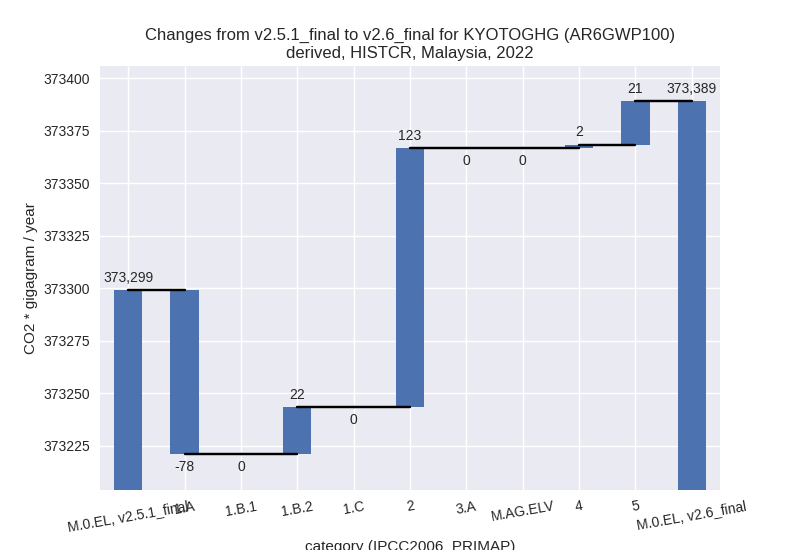

1990-2022
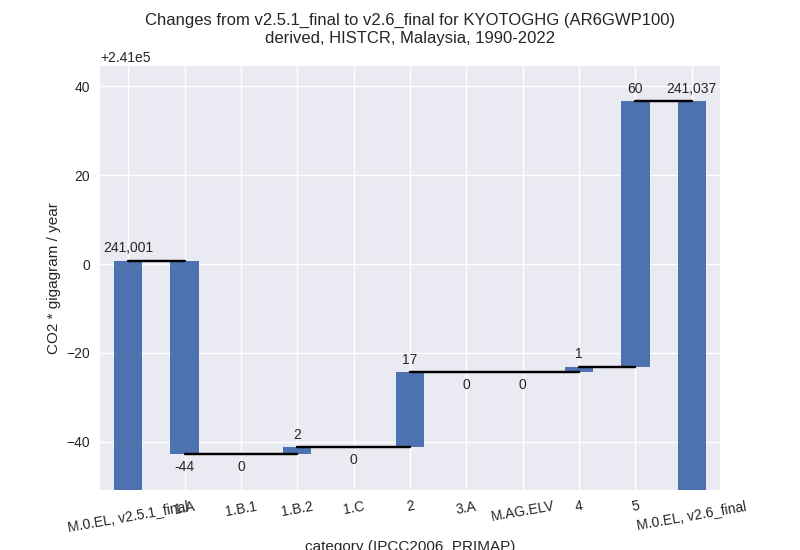
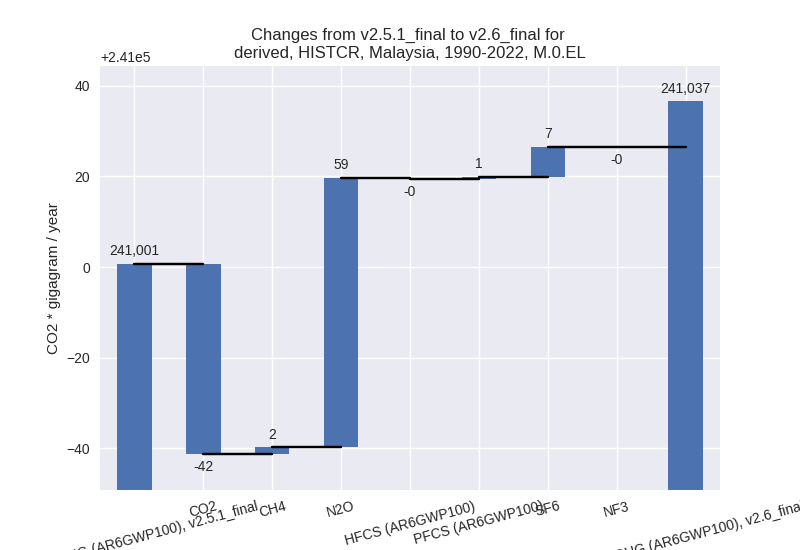
third party scenario
2022
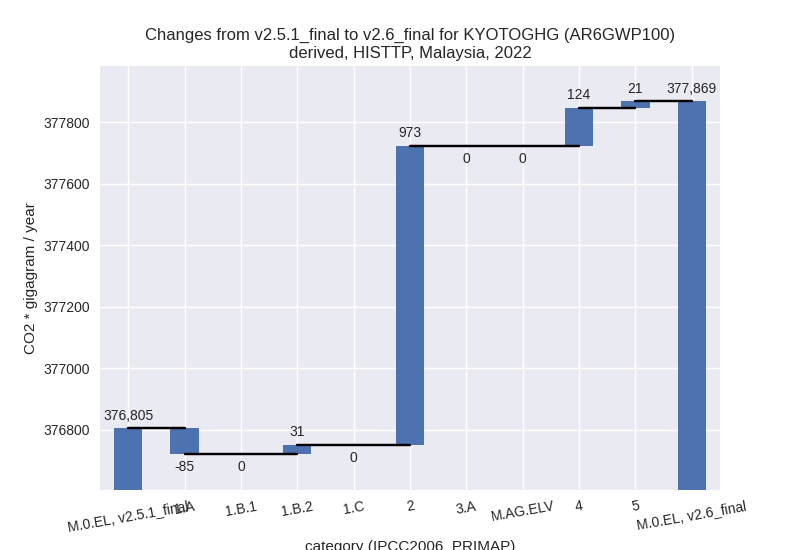
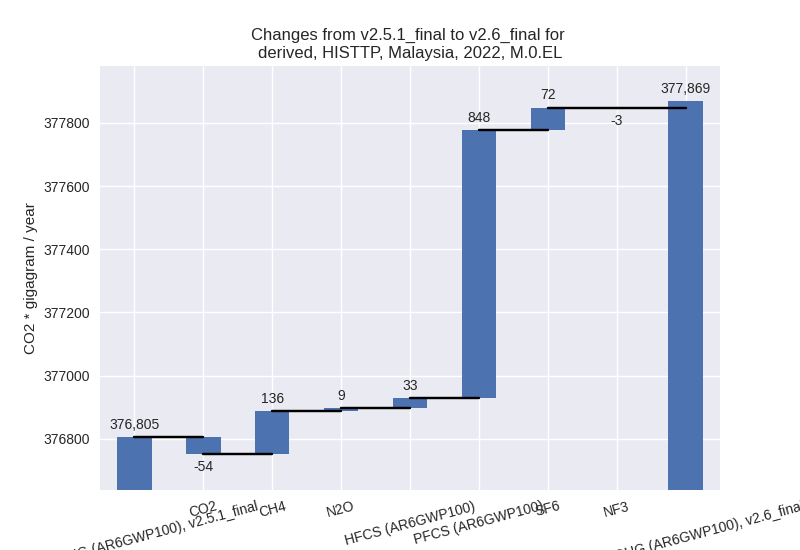
1990-2022
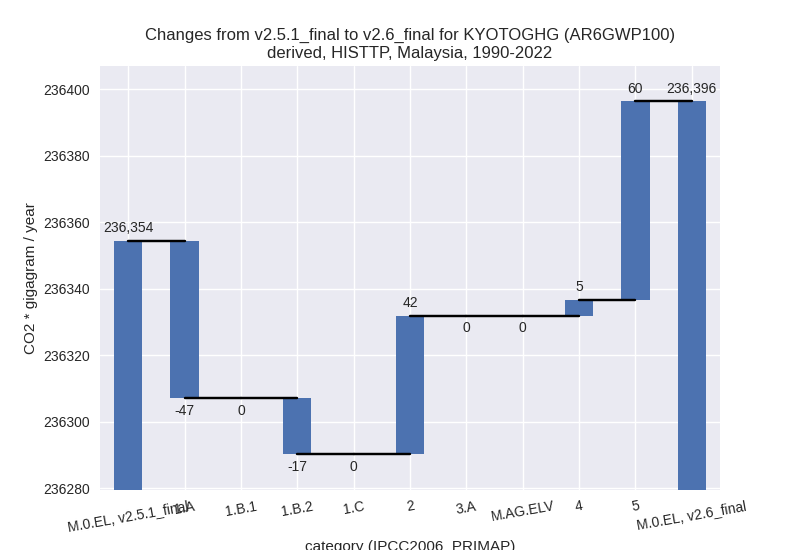
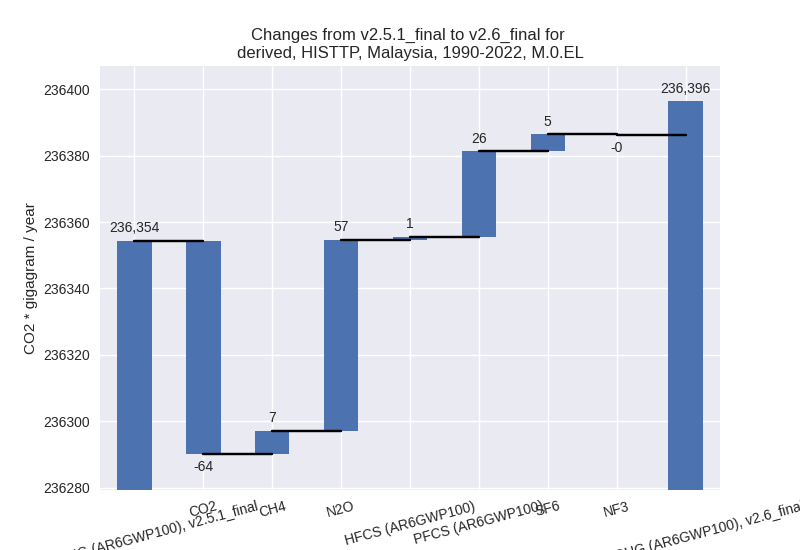
Detailed changes for the scenarios:
country reported scenario (HISTCR):
Most important changes per time frame
For 2022 the following sector-gas combinations have the highest absolute impact on national total KyotoGHG (AR6GWP100) emissions in 2022 (top 5):
- 1: 2, SF6 with 91.99 Gg CO2 / year (14.6%)
- 2: 1.A, CO2 with -77.98 Gg CO2 / year (-0.0%)
- 3: 1.B.2, CO2 with 22.34 Gg CO2 / year (0.8%)
- 4: 5, N2O with 20.57 Gg CO2 / year (2.0%)
- 5: 2, PFCS (AR6GWP100) with 17.13 Gg CO2 / year (0.2%)
For 1990-2022 the following sector-gas combinations have the highest absolute impact on national total KyotoGHG (AR6GWP100) emissions in 1990-2022 (top 5):
- 1: 5, N2O with 59.68 Gg CO2 / year (8.0%)
- 2: 1.A, CO2 with -43.52 Gg CO2 / year (-0.0%)
- 3: 2, SF6 with 6.56 Gg CO2 / year (2.3%)
- 4: 4, CH4 with 1.54 Gg CO2 / year (0.0%)
- 5: 1.B.2, CO2 with 1.51 Gg CO2 / year (0.0%)
Changes in the main sectors for aggregate KyotoGHG (AR6GWP100) are
- 1: Total sectoral emissions in 2022 are 283089.97 Gg CO2 / year which is 75.8% of M.0.EL emissions. 2022 Emissions have changed by -0.0% (-55.64 Gg CO2 / year). 1990-2022 Emissions have changed by -0.0% (-42.01 Gg CO2 / year).
- 2: Total sectoral emissions in 2022 are 44441.23 Gg CO2 / year which is 11.9% of M.0.EL emissions. 2022 Emissions have changed by 0.3% (123.24 Gg CO2 / year). 1990-2022 Emissions have changed by 0.1% (16.86 Gg CO2 / year).
- M.AG: Total sectoral emissions in 2022 are 11016.83 Gg CO2 / year which is 3.0% of M.0.EL emissions. 2022 Emissions have changed by 0.0% (0.00 Gg CO2 / year). 1990-2022 Emissions have changed by 0.0% (0.00 Gg CO2 / year).
- 4: Total sectoral emissions in 2022 are 33768.53 Gg CO2 / year which is 9.0% of M.0.EL emissions. 2022 Emissions have changed by 0.0% (1.76 Gg CO2 / year). 1990-2022 Emissions have changed by 0.0% (1.30 Gg CO2 / year).
- 5: Total sectoral emissions in 2022 are 1072.40 Gg
CO2 / year which is 0.3% of M.0.EL emissions. 2022 Emissions have
changed by 2.0% (20.57 Gg CO2 /
year). 1990-2022 Emissions have changed by 8.0% (59.68 Gg CO2 / year). For 1990-2022
the changes per gas
are:
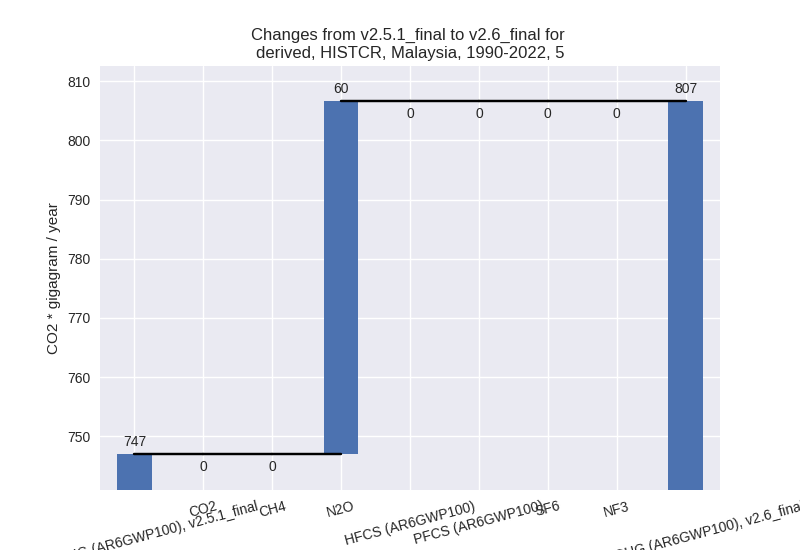
third party scenario (HISTTP):
Most important changes per time frame
For 2022 the following sector-gas combinations have the highest absolute impact on national total KyotoGHG (AR6GWP100) emissions in 2022 (top 5):
- 1: 2, PFCS (AR6GWP100) with 847.63 Gg CO2 / year (50.9%)
- 2: 4, CH4 with 135.64 Gg CO2 / year (0.8%)
- 3: 1.A, CO2 with -84.56 Gg CO2 / year (-0.0%)
- 4: 2, SF6 with 72.04 Gg CO2 / year (11.4%)
- 5: 2, HFCS (AR6GWP100) with 32.95 Gg CO2 / year (3.2%)
For 1990-2022 the following sector-gas combinations have the highest absolute impact on national total KyotoGHG (AR6GWP100) emissions in 1990-2022 (top 5):
- 1: 5, N2O with 59.68 Gg CO2 / year (8.0%)
- 2: 1.A, CO2 with -47.19 Gg CO2 / year (-0.0%)
- 3: 2, PFCS (AR6GWP100) with 25.69 Gg CO2 / year (3.0%)
- 4: 1.B.2, CO2 with -17.03 Gg CO2 / year (-0.5%)
- 5: 4, CH4 with 7.03 Gg CO2 / year (0.1%)
Changes in the main sectors for aggregate KyotoGHG (AR6GWP100) are
- 1: Total sectoral emissions in 2022 are 321357.11 Gg CO2 / year which is 85.0% of M.0.EL emissions. 2022 Emissions have changed by -0.0% (-53.72 Gg CO2 / year). 1990-2022 Emissions have changed by -0.0% (-64.22 Gg CO2 / year).
- 2: Total sectoral emissions in 2022 are 26557.15 Gg
CO2 / year which is 7.0% of M.0.EL emissions. 2022 Emissions have
changed by 3.8% (972.65 Gg CO2 /
year). 1990-2022 Emissions have changed by 0.3% (41.71 Gg CO2 / year). For 2022 the
changes per gas
are:
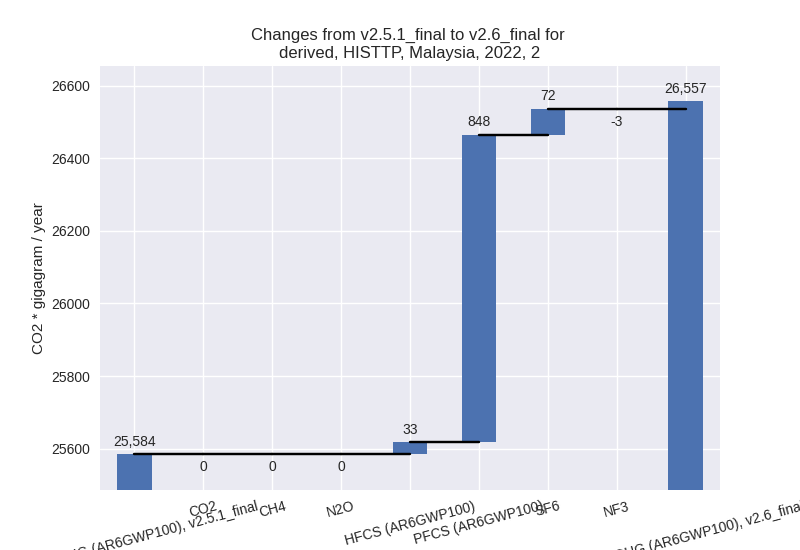
- M.AG: Total sectoral emissions in 2022 are 12088.31 Gg CO2 / year which is 3.2% of M.0.EL emissions. 2022 Emissions have changed by 0.0% (0.00 Gg CO2 / year). 1990-2022 Emissions have changed by 0.0% (0.00 Gg CO2 / year).
- 4: Total sectoral emissions in 2022 are 16793.69 Gg CO2 / year which is 4.4% of M.0.EL emissions. 2022 Emissions have changed by 0.7% (123.74 Gg CO2 / year). 1990-2022 Emissions have changed by 0.0% (4.78 Gg CO2 / year).
- 5: Total sectoral emissions in 2022 are 1072.40 Gg
CO2 / year which is 0.3% of M.0.EL emissions. 2022 Emissions have
changed by 2.0% (20.57 Gg CO2 /
year). 1990-2022 Emissions have changed by 8.0% (59.68 Gg CO2 / year). For 1990-2022
the changes per gas
are:
